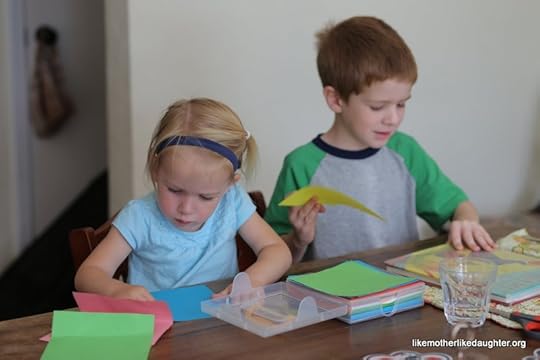Leila Marie Lawler's Blog, page 48
July 15, 2016
Finding sacred time ~ The Spirit of the Liturgy, A Book Club

{Book Club: The Spirit of the Liturgy}
I hope you will read along in this book club (or just read my posts, that’s okay): Joseph Ratzinger’s The Spirit of the Liturgy.
(When you buy something via our Amazon affiliate link, a little cash rolls our way… just a little. Thanks!)
I’ll post on Fridays, although for this longer book, perhaps not every Friday. I’ll give you your homework, I’ll talk about what we read, we’ll discuss in the comments. Even if you read later, the comments will still be open.
Previously:
Introduction to the reading: Joseph Ratzinger’s The Spirit of the Liturgy: A Book Club for Easter and Beyond
Nature or history in worship? Or both?
The Relationship of the Liturgy to Time and Space: preliminary questions
The Reservation of the Blessed Sacrament
Homework: Read Chapter One of Part III.
Chapter Five, Part II: Sacred Time
Of course, I love all the chapters of this book.
But this one speaks so deeply to us, we who are trying to live family life with a sense of beauty, order, and wonder. We are raising our children, and we want them to be connected with each other, with us, with the larger human family, with nature and the whole of creation, and with God. We want to worship in a connected way. I believe that is what we are all searching for. And we wrestle with time.
The questions that is answered in this chapter are the following: Is time something we ought to mark? How? Is the way we celebrate feasts arbitrary, or not — and if not arbitrary, why not?
(Did you find this chapter a little rougher than some of the others? Try reading the last paragraph first.)
Obviously, the first question is simply, “What is time?”
We could get lost in a philosophical discussion, but since Cardinal Ratzinger declines to do so, we will follow his example. It’s true that Aristotle observed that time is the principle of corruption. And for anyone on this earthly journey, it can seem that time and eternity are separate.
But for Christians, things are different. As we’ve been reading, we’ve seen how Jesus Christ is the bridge. He became Incarnate “and drew time into the sphere of eternity…. in the Son, time co-exists with eternity.”
Time is a given. But it’s not strictly linear — it has a rhythm. This rhythm is set by the sun and the moon. “The first thing to say is that time is a cosmic reality… the course of the sun and the moon leaves its mark on [man’s] life.”
After considering the many facets of how time is marked in nature, Ratzinger begins with the weekly rhythm and the question of the Sabbath: Is the Sunday the new Sabbath? The connection between Old and New, we have seen, is crucial for Christianity. The Sabbath is the original Covenant that God makes with man. But now we have the New Covenant:
Jesus’ giving of himself unto death gives the words he speaks at the supper their realism…. only through the Resurrection does the covenant come fully into being,” uniting man with God. “Thus, the Day of Resurrection is the new Sabbath.
On page 96 we have a fantastic discussion of the importance of number in this covenant. I will try to unpack it for you, the “three different names for this day” — the Sunday.
It’s the third day, seen from the Cross: “the day of theophany, the day when God entered into the world.” Death and Resurrection give the Incarnation its full meaning for man.
It’s the first day, in terms of the week: It’s the beginning of creation, the new day, the day of rebirth, the day of the sun. Jesus has emerged from the “virgin tomb” just as he emerged from the virgin womb, inaugurating a new covenant for man.
It’s the eighth day, looking back on the week, because it’s the seventh day (last day of the week, Sabbath in terms of the Old Testament, the old creation) and first day (first day of the week) — giving it significance as the eighth day, which is the “new time” connected with eternity, the heavenly day! Here we see again our spiral. The closed circle of the week is opened up — upwards!

The massive and magnificent Florence Baptistery, which is eight-sided as are many baptismal fonts and chapels, to symbolize the truth that the Sacrament of Baptism gains us entry into heaven.
Sunday is “time’s proper measure” — it is not arbitrary. We can’t have a day of rest to fulfill the Commandment on any other day. Sunday is Sunday.
Likewise, “Jesus did not want to die on just any date.” Now this opens up all sorts of questions about when to celebrate Easter. And I will say that this section certainly might cause a little eyes-rolling-up-in-their-sockets action, but stick with it just a bit.
What was essential was the connection with the date of the death and Resurrection of Jesus, which was of its very nature linked with the Jewish liturgical calendar. Now this link, raising as it does the question of the relation of New Testament to Old and of the newness of Christianity, was to have explosive potential.
The Council of Nicaea (325) had to settle the question of whether to fix the day by the lunar calendar (following the Jews and the celebration of Passover) or the Sunday, which relates to the solar rhythm. The Council determined that Easter should be celebrated on the Sunday after the full moon of the spring. “Through [the Council’s] ruling, the solar and lunar calendars were interconnected, and the two great cosmic forms of ordering time were linked to each other in association with the history of Israel [the Passover] and the life of Jesus [the Resurrection].” (P. 99)
And it gets more interesting! When the question arose of when the latest date of Easter could be, St. Leo the Great made it clear that according to Scripture, Easter should fall in the first month — “not April, but the time when the sun is passing through the first part of the Zodiac — the sign of Aries. The constellation in the heavens seemed to speak, in advance and for all time, of the Lamb of God, who takes away the sins of the world” — and, of course, the prefiguration of Christ in the story of Isaac and his “replacement” sacrifice of the ram, caught in the thicket.
And don’t miss how the date of Easter ties in with the significance of March 25 (the feast of the Annunciation of the Angel Gabriel to the Virgin Mary), on page 100.
“It seems clear to me,” Ratzinger says, “that we have to recapture this cosmic vision if we want once again to understand and live Christianity in its full breadth.”
What does he mean? He is saying here that we are hungering for this connection with history and with the stars. Without even knowing it, the connection is there. “That is why the calendar of the Christian feasts is not to be manipulated at will.”
When pondering the very beautiful rhythm of the seasons of nature in concert with the liturgical seasons, I often guiltily wondered about our dear antipodean friends. What about those who end up celebrating Christmas at the beach? How can Easter come during Autumn?
Well, our dear Pope Benedict anticipates just this question. On p. 103 he even brings up the issue of inculturation. Ought things to be changed on account of those living in a different hemisphere? He says, “If the cosmic symbolism is so important, ought we not to adjust the liturgical calendar for the Southern Hemisphere?… if we did this, we would reduce the mystery of Christ to the level of a merely cosmic religion… the cosmic serves the historical… we are not chasing myths… God really has acted in our history and taken our time into his hands.”
And he goes on to show that within each event in Christ’s life are contained all. Even over the darling coziness of the manger hovers the menace of Herod’s edict; even while contemplating the babe in his mother’s arms, we can’t escape the innocents’ death. “Christ connects the world’s spring and autumn.” (P. 104)
Many times we hear the scornful “fact” from popular experts that Christmas is celebrated on December 25 because Christians were co-opting pagan sun-worship or Roman imperial religion, as though the Gospel story is without any sort of intrinsically compelling narrative of its own.
[T]hese old theories can no longer be sustained. The decisive factor was the connection of creation and Cross, of creation and Christ’s conception… these dates brought the cosmos into the picture… the pre-annunciation of Christ, the Firstborn of creation (cf. Col 1:15). It is he of whom creation speaks, and it is by him that its mute message is deciphered. (P. 108)
You might as well say that the pagans were dimly miming some reality the details of which they were unaware, or the Romans were unconsciously patterning their artificial religion on the real one. Those explanations make more sense!
St. Jerome: “Even creation approves our preaching. The universe itself bears witness to the truth of our words. Up to this day [Christmas Day] the dark days increase, but from this day the darkness decreases…”
So this chapter looks closely at Easter, the fulfillment of the mission of Jesus Christ, and Christmas, the great feast of his Incarnation, to demonstrate that the celebration of these feasts fits with history and nature. Of course, all the other feasts flow from these two, and all are ordered to God — but so is the sun and so is the moon. Thus, so is time itself.
When we think of the moon, we think of how it “has no light of its own but shines with a brightness that comes from the sun. This is a sign to us that we men are in constant need of a “little” light, whose hidden light helps us to know and love the light of the Creator, God one and triune.”
These “little lights” are the saints, whose feasts are kept in the sacred time, in the rhythm of the passing year. Just as the stars feed our souls, so does the beauty of holiness. Beauty, the radiance of truth, is known to us within time — that is to say, in creation — by means of holiness. We can’t do without God’s saints, any more than we can do without the radiance of nature (beautiful things of creation) or of art (beautiful things made by man).
And it must be so:
One might say that the saints are, so to speak, new Christian constellations, in which the richness of God’s goodness is reflected. Their light, coming from God, enables us to know better the interior richness of God’s great light, which we cannot comprehend in the refulgence of its glory.
Were there any other passages you’d like to talk about?
Questions? Comments? I’d love to hear from you!
(Emphases added in quotes are mine.)
Click here to see our previous discussion of Romano Guardini’s The Spirit of the Liturgy, which you can read free, online. You can also purchase it here, although be warned, this edition does not have the footnotes, which stinks .
.
The post Finding sacred time ~ The Spirit of the Liturgy, A Book Club appeared first on Like Mother Like Daughter.
July 14, 2016
A day off.

No {pretty, happy, funny, real} today, although you can post a picture on Instagram and tag it #prettyhappyfunnyreal or #phfr if you like.
I hope to be in tomorrow with another chapter of The Spirit of the Liturgy!
The post A day off. appeared first on Like Mother Like Daughter.
July 12, 2016
Plain Cooking: Surviving Morning Sickness and More
Quick disclaimer: I rarely had more than little waves of nausea while pregnant. Before you hate me, I want to tell you that my observation, backed up by multiple studies at the National Institutes of Health (or, maybe not), is that those with easy pregnancies often have difficult deliveries, and vice versa. Does that make you feel better? I’ll wait while you run to the bathroom… poor you.

Okay.
But I have some strategies for you to cope with morning sickness, and some tips. With my admittedly scant experience and surveys of truly morning sick friends, this post will help.
The main issue is how to feel a little better — but also, how to feed everyone when you feel lousy.
The solution to this two-horned problem: Plain Cooking.
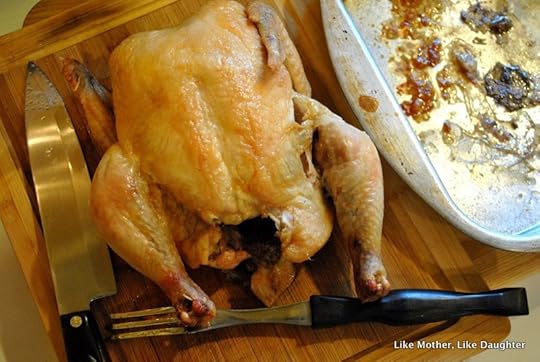
As I see it, we have these levels of morning sickness:
Defcon 1: You are still on Pinterest and can manage to layer dips, garnish salads with edible flowers harvested from your garden, and handle recipes embedded in other recipes. You can stomach the sight of raw chicken. You are not particularly too tired to have a garden. Good for you! We’ll be over for supper.
Defcon 2: You walk rather fast past the chicken case at the grocery store. A dish of squid you mistakenly ate in week 9 has put you off squid forever. Never again will you eat squid. You can barely type the word. Your family wonders why chicken has disappeared from the menu, although some of them aren’t sad about this (and they are four). Ways to make ground beef are paling, but you’re sticking with it. As long as the 5-year-old keeps you supplied with Nerds, you are going to make it. By week 20 you are feeling okay as long as you have one nap a day. (This may or may not have been me. At my worst. I said I was sorry.) You’re doing fine, really.
Defcon 3: Dragging from sofa to bed, bed to sofa, barfing along the way. Wishing you had the energy to strangle the next person to tell you to drink ginger ale. Here is where perhaps we can be of help.
First let’s look at how to feed your family in this case.
I think rules are in order, don’t you? Thinking/understanding is so hard when you are morning sick. Three warm-up rules and then on to Plain Cooking.
Rule 1: Get the medical part of it squared away. Have your blood tested for iron. Your prenatal pill’s iron is probably not enough. Take your Floridix (or these easily swallowed, reasonably sized pills if you don’t think you can handle swallowing the liquid). Iron can worsen nausea but so can feeling extremely draggy. Just try to take it later in the day when you’ve eaten something (non-dairy).
If you can eat red meat or liver, do. Try my liver paté — maybe someone can make it for you — if you can handle it, and you might find that you actually crave it if you are iron deficient. Liver + prunes = iron and a little help with consequent digestive issues. There are combinations of vitamins that can help you — ask your midwife. But above all, don’t get anemic on top of everything else.
There are safe medications for morning sickness. Many ladies swear by the Vitamin B6 plus Unisom combination. You need to bring it up with the doctor — we’ve heard too many stories of ladies needing IV fluids more than once — yet the doctor still doesn’t bring up medical relief. Getting that dehydrated is far worse for baby than taking the (safe!) medication!
Rule 2: Rest. You are making a baby. That’s pretty important and amazing. If this is not your first child, you are making a sibling for your other child(ren) — the best gift you will ever give them, besides your marriage. You don’t have to do anything else for them in the way of activities, entertainment, etc., and not only will your kids survive, they will thrive, because they will do all the things. You will see. When you can’t, they will.
Sometimes I think this is obvious, to rest — but then I see ladies running around and realize that unless you have my voice in your head, you might not know that you can just go lie down. (But if you literally can’t move, you might be anemic — see #1.)
Remember, you might not look all that pregnant, and thus you might feel like a real scrub for feeling bad, but all the hard work of making fingers and toes is taking place right now! No wonder you can’t cope!
If “the others” are only 18 months old, then yes, it’s tricky to have to check out, but you’d be surprised how little an 18-month-old needs. If you are skeptical, remember this anecdote a friend once told me when I was lamenting a bout of sickness where I felt incapacitated. She said, “Once I was so sick and no one was there to help me. I basically lay on the sofa and held out a banana. The [little] kids ran around in circles in the living room, stopping as they passed for a bite.” I don’t know how much lower the bar can be, so just think of that and congratulate yourself for holding it together.
Get a fence and let the kids run around outside. When people ask what you need, tell them you need a fence.
Rule 3: When you can do something, try to do it fast. It’s better to do something really quickly and then go back to the sofa than to move slowly for a long period of time. Train yourself to think beforehand what the fastest way to do any particular thing might be, and then do it that way. A sweet, severely morning sick reader to whom I wrote this thought commented:
Thank you so much for that advice. It was actually more helpful than you may realize because I can be a sort of “slow to get moving” type of girl. The reminder to work quickly when able is most applicable.
Rule 4: Familiarize yourself with Plain Cooking. When you are able, just cook the food. Do not Pinterest it, do not Julia-Child it.
Everything is fine with butter and salt.
Cooked meat lasts a couple of days in the fridge and cooked vegetables last for longer than that.
Boil or bake potatoes. Heck, microwave them. I laughed when I saw a New York Times article about “the right way to bake a potato.” There is literally nothing easier than baking a potato. Put butter and salt on it when it’s done. You’re good.
Yes, there are entire cookbooks for how make chicken breasts interesting. But you can also get a pan, melt butter in it, throw the breasts in, cook them. Salt. Eat.
Roast a whole chicken. Just salt it and put it in the oven. Roast it for 15 minutes per pound. Take it out. Hack pieces off of it. Put it in the fridge. Take it out. Hack more pieces off of it. Repeat until nothing is left.
Put chuck roasts and pork shoulders in the slow cooker (I mean, not together) with some tomato paste and dried onion and salt. You don’t need to add water to the pork. You can add a cup or two of water, wine, or broth to the beef. Cook until the meat is tender, 6 or so hours. If it’s not tender, cook it some more. If you can’t open a can of tomato paste, that’s fine. It will be fine.
Get pork chops. Melt butter in a pan. Brown chops on one side. Turn over. Salt. Cover and cook on low heat for 8 minutes (depending on thickness). Eat.
Sometimes you need to know that you can open a jar of sauce: Boil pasta. Brown beef (add salt). Open jar of tomato sauce (store brand is fine). Pour over beef. Pour over pasta. Serve with parmesan cheese or even grated cheddar cheese.
Brown ground beef. Add dried minced onion and salt. Serve over potatoes. Put a dollop of sour cream on top if you want to be fancy.
Or put it in a tortilla. Anyone who can open the fridge can get some things to add to that.
Truly, a child can do any of these things. You only have to tell them about washing their hands and the counters with soap. If your child is too young, even your hard-working husband can take 10 minutes and do them. If necessary, you can give directions from the sofa.
Just think “meat, starch, vegetable, bread.” If all else fails, bread and cheese.
To get slightly more complicated in case the fog clears or someone is there to help:
You can serve BBQ sandwiches with the cooked meat. Leftover braised (as above, in the slow cooker) meat, BBQ sauce, rolls. Ground beef, BBQ sauce, potatoes. I think that Ray’s BBQ sauce is made with sugar, not high fructose corn syrup. Always have some of that handy, along with bulky rolls in the freezer.
Make a pot of rice and put your cooked meat and vegetables on top and tell a child to get the soy sauce.
Get a ham (have your husband pick it up for you — one with a bone, pre-sliced or not), bake it by throwing it in a pan with sides and the oven on 325º. In the same oven, put sweet potatoes on a baking tray covered with foil. (Do not omit the foil, because we don’t want you scrubbing pans.)
Take the ham out, turn the oven up to 425º, continue to cook the sweet potatoes until they are oozing sugar. Boil some green beans.

(The picture is of the cold sweet potatoes. When they were cooking, they were spread out — on the foil — on a larger pan. Note how I stored them.)
Open the sweet potatoes and serve with butter and salt. Once you taste roasted sweet potatoes, you will love them. I literally made it through childhood without eating one green item, thanks to sweet potatoes.
Another day, have ham sandwiches — just bread, butter, and ham, fruit or pickles and chips on the side.
Another day, soup with the bone — pea soup couldn’t be easier. Throw the peas with the bone into the slow cooker, add dried minced onion, two quarts of water. Salt at the end.
Another day, cook up some pasta and put the ham and green beans in the cooked pasta with butter and cheese.
Get these:
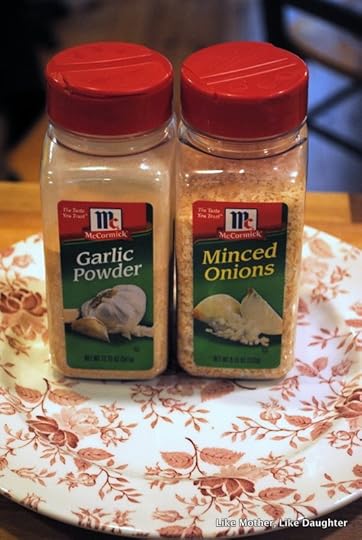
Mustard (just plain powdered mustard seed) and garlic powder make any meat taste fine if someone wants to add them to the pot.

If the defcon level can be downgraded:
Put that chicken carcass that’s been picked clean in a pot. Throw your dried onion flakes in. Boil. Strain. Cook noodles in it, maybe a chopped up carrot (do the carrot pieces first). (When you get your onion flakes, also get a big container of dried parsley — shake some parsley in.) There you go. Lots of bread and butter.
Caesar salad: send someone out for a big package of Romaine lettuce, parmesan cheese, anchovies (really — you might find you crave this), and Italian bread. They could break Auntie Leila’s rule this once and buy Caesar salad dressing, although it’s just oil, vinegar, mustard, salt, and garlic (we’ll leave the egg yolk out of it for now). Put the leftover chicken next to this salad and you’re good to go.
The main thing– use your limited cooking time well. If you can do it, cook as big a roast or as many chicken parts as you can manage so that you can put some in the freezer. (Have plenty of ziploc freezer bags on hand to make this as easy as possible.)
Make a big pot of pasta, toss with olive oil. You can have many meals that are pasta, cheese, some pieces of meat, some vegetables. All of that has been in your fridge — just microwave. The same can be done with potatoes or rice.
Don’t worry, you will get through this. Some day you will cook with recipes again. For now, just aim to have some cooked food on the table.
Some tips for actually quelling the nausea — and I realize that so far I’ve suggested liver and anchovies, but seriously, this could help:
You eat whatever you can eat. If that means pastries or ice cream or cheeseburgers or salted nuts, that’s what you should eat. You need calories.
Do try to make it something with protein if you can. Yes, salty crackers can help, but you need to quickly follow up (or go straight to) cheese, yogurt, pieces of cooked meat, nuts. You might be able to eat a sharp, salty cheese like feta.
Your aim is to keep the blood sugar levels even, so eat — and drink — at frequent intervals.
Don’t try to choke something down. We women have been conditioned to cling to the notion of salad as our one healthy option, but salad might not be for you right now. Suki’s husband would leave half a peanut butter sandwich by her bedside. She would have a little milkshake (made by that excellent husband) right before supper so that she could eat supper — because getting too hungry spirals quickly. And eating cold things can help, so obviously ice cream is ideal.
Try not to smell the things. This makes the crockpot a bit more tricky, I realize. I haven’t actually put my new Instant Pot to the test (it’s on sale today, by the way!), but I think it would be better on that account.
On the other hand, Deirdre suggests sniffing a cut lemon — it helped her. I found that sniffing a tea bag helped me.
Sometimes you can eat if someone just puts it in front of you. Don’t say you can’t eat it until you really know for sure. Thinking about it might be worse than eating it. The time I was sickest, I couldn’t stand to hear the words ham, broccoli, or cheese sauce, but when handed a plate of just that, I could eat it.
Whatever is the thing you can most see yourself eating, just serve that as simply as possible.
Magnesium and Vitamin D really help with feeling better, and magnesium is best absorbed through the skin. So a foot bath or actual bath with Epsom salts is soothing and actually delivers the magnesium — far better than in pill form. You can get a big bag at the drugstore.
Taking cod liver oil can help with the vitamin D. Yes, this is a two-edged sword for sure, and there are capsules. The issue is… burping. Deirdre suggests taking it before bed so you are asleep when you burp!
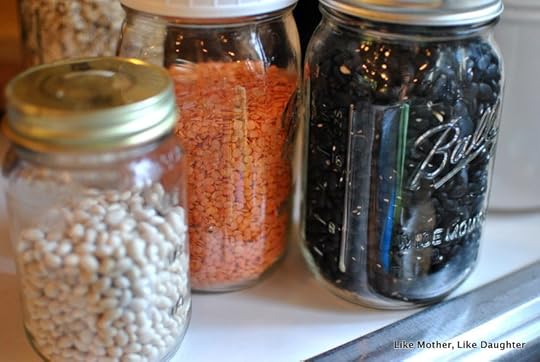
Something odd that might just work to quell the queasiness:
A few years back I read a post (sorry, the link is long gone from memory!) by a mom of many kids who got very sick every time — she said that the only thing she could eat was cooked beans. She would just make a pot of beans every few days and eat that. If you want to try it, white navy beans are very bland when cooked up (they don’t smell too great when they are cooking, I’ll grant you, but they are very mild once cooked). Try eating them with bread or rice for complete protein, and do add oil or butter, and salt.
Try cooking up a pot of red lentils (use twice as much water after rinsing them) with dried minced onion and salt. It’s very tasty and doesn’t take long.
I have no experience with this bean thing as a remedy for morning sickness — just passing it along.
Sometimes nausea is actually from acid reflux, so try to get that under control. Relieve constipation (the sweet potatoes really help with that, as does flax, and dates, which you should be eating anyway for your labor). Tums, Zantac. It can also be due to low acid, so taking an apple cider vinegar drink or lemonade can help.
There’s still Defcon 4… Walking around with a little suitcase containing IV fluids. Aw. This is so hard. Please rest and be cared for. We don’t know what to say, other than maybe look at the tips above and see if you can manage them or pass them to your husband; and Defcon 5… Hospitalization: Auntie Leila is so sorry and has even less to tell you, other than to direct your husband to this post, which will also help anyone who isn’t able to be very handy around the kitchen, even if not actually carrying the baby around inside their actual bodies.
(Hence, the “more” of the title. It’s just good to remember, for lots of dire circumstances, that you — or someone else — can keep it simple.)
Hyperemesis gravidarum is so serious, and we are on your side.
Some possibly consoling thoughts:
A friend who does get morning sick told me recently about a real upside to her most recent pregnancy, and this relates to meal planning directly. She decided she just had to keep it very simple and not cater to her other children’s pickiness (they were all under six at the time) — because she just could not. She got what she could on the table and that was that, and it was usually the same thing many days in a row.
And you know what? They became very hearty eaters!
If none of this helps, let it go, just let it slide. What helps one gal might not help you, and vice versa. It’s okay.
Please join or form a St. Greg’s Pocket as soon as you can. We all need a community to help us through these times. We can’t do it on our own. When you’ve been through it, you know what to do — which is more than I can say for most people. Be there to help others and they will help you.
In any case, everyone has their fight to fight, and I want you to know that we all have those times that things fall apart. You do your best and you know that God sees you and loves you.
Sometimes I think that we have these times in our lives so that we learn humility and that we aren’t meant to be “perfect” — how else will we ever empathize with anyone?
I do have these posts:
Resolutions for doing what you can, and 10 survival tactics for rescuing a bad day.
They might help with just figuring out how to muddle through and make best use of whatever good moments you have. Short version: work fast when you can, do the minimum! and find good videos (lots of ideas in that survival post) and books for the kids.
Remember that offering up your suffering is the way God asks us to be united with Him. It isn’t wasted — you will never know until you get to Heaven how your lonely, silent suffering helps others. But it does.
What ways have you found for coping with morning sickness, especially with other family members to take care of?
The post Plain Cooking: Surviving Morning Sickness and More appeared first on Like Mother Like Daughter.
July 9, 2016
{bits & pieces} & All About Books
The weekly “little of this, little of that” feature here at Like Mother, Like Daughter
What’s both exciting and disappointing about this little collection of books?

The exciting and fun part is that I received them for free and they are now part of my family library, to sit on my shelves for my children to observe and wonder about and, someday, pick up and read.
The disappointing part is that the reason they were free is that my library was getting rid of them, which means that the people in charge were making room on the shelves by getting rid of old (to them: “outdated”) books that weren’t circulating. No one was reading them, so they were deemed dead weight. The very purpose of the library – a place for great works to be treasured for the ages and accessed by the public – is undermined.

The way I see it, I owe it to the world to pick up where the public library left off, and perhaps someday donate these back to a library in the hopes that they’ll be rediscovered — after my family has absorbed them. In addition, I’m considering making it a point of “intellectual charity” to borrow great books from the library, if for no other reason than just to simply keep them in circulation!
I’m inspired to give you a little {b&p} feature: a usual list of links is below, but for now I just want to give you a collection from our Archives, in case you need to catch up on the Library Project:
The Like Mother, Like Daughter Library Project – an introduction to what we believe a library should be, and the concept of this non-list we’re offering
To Educate Children, you Need Books on the Shelves – permission to acquire and collect any and all books of quality!
Just Say No to “Books that Build Character” – includes recommendations for great stories that will contribute in the long run to what you can’t do with a shortcut
Library Project: Should Parent or Child Choose?
Looking for more? See the item in the header menu, above! You can scroll through all the past Library Project posts for more thoughts on books in general and recommendations for specific ones that are worthy of adding to your collection.
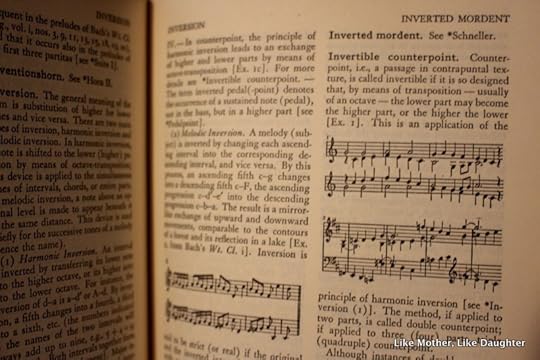
~~
On to this week’s links!
For deeper reading:
Anthony Esolen alert! This week we recommend his article The Uses of Disgust. We need this interesting reminder to keep our moral reactions simple. From the article: “You do not say to someone who has brought himself to dine upon feces, so that it is to him an evil second nature, “You know, you should really check a dietician about that.” Nor do you say anything similar to your children. You rely upon their natural sense of disgust: you corroborate it and you direct it. Everything genuinely natural is your ally.”
Prepare to be moved by this inspiring in memoriam piece about Lizz Lovett, a young woman who witnessed to life while dying of cancer. Written by a friend of Rosie’s, this article also includes Lovett’s funeral homily by our dear Fr. Scalia. It also includes this video, in which Lovett offers her story as part of the campaign against euthanasia (legal in her home state of OR):
Some reading to help you prepare to take appropriate action by urging your representatives about the upcoming vote on the Conscience Protection Act!
And lighter & miscellaneous:
You know how I love a good wedding celebration. And we LMLD girls are self-proclaimed wedding-photo addicts. But this shoot I liked in particular because of how it features a cross-generational party. Just some inspiration for how the whole family, young and old, can enjoy a wedding feast together. Laura & Mark’s Rhode Island Wedding. (Discerning readers will recognize some crossover material from my posts about receptions.)
Have you heard about Simone Biles? The young American gymnast phenom who’s slated to, in Rosie’s words, tear it UP at the Olympics this summer? Also: a short video showing and explaining how she’s a head and shoulders above the rest (at less than 5′ :).
A hilarious and endearing interview with the great P.G. Wodehouse, at age 91. On writing, humor, self-reflection… Let’s just say that he doesn’t seem to suffer from false modesty. (Don’t miss the Library Project post on Wodehouse!)
This writer has apparently made a study of the super rich, and diagnosed such wealthy folks with Perfection Anxiety. From Auntie Leila: “Read with your older children (teens) to appreciate a well written essay and to discuss what too much money would do to your life. Is it true that only the extremely rich have perfection anxiety? Is money the cause of this anxiety? Or is it something else?”
In the Liturgical Year:
Today is the memorial of St. Augustine Zhao Rong and his companions, Chinese martyrs!
~We’d like to be clear that, when we direct you to a site via one of our links, we’re not necessarily endorsing the whole site, but rather just referring you to the individual post in question (unless we state otherwise).~
Follow us on Twitter.
Like us on Facebook.
Auntie Leila’s Pinterest.
Rosie’s Pinterest.
Sukie’s Pinterest.
Deirdre’s Pinterest.
Habou’s Pinterest.
Bridget’s Pinterest.
Habou’s Blog: Corner Art Studio.
Auntie Leila’s Ravelry.
Auntie Leila’s Instagram.
Rosie’s Instagram.
Sukie’s Instagram.
Bridget’s Instagram.
Save
The post {bits & pieces} & All About Books appeared first on Like Mother Like Daughter.
July 8, 2016
Is the Eucharist for eating or for looking at? ~ The Spirit of the Liturgy, A Book Club

{Book Club: The Spirit of the Liturgy}
I hope you will read along in this book club (or just read my posts, that’s okay): Joseph Ratzinger’s The Spirit of the Liturgy.
(When you buy something via our Amazon affiliate link, a little cash rolls our way… just a little. Thanks!)
I’ll post on Fridays, although for this longer book, perhaps not every Friday. I’ll give you your homework, I’ll talk about what we read, we’ll discuss in the comments. Even if you read later, the comments will still be open.
Previously:
Introduction to the reading: Joseph Ratzinger’s The Spirit of the Liturgy: A Book Club for Easter and Beyond
Nature or history in worship? Or both?
The Relationship of the Liturgy to Time and Space: preliminary questions
Homework: Read Chapter Five of Part II.
Chapter Four, Part II: The Reservation of the Blessed Sacrament
Do you notice that as soon as I start posting about orientation, Cardinal Robert Sarah, the prefect of the Congregation for Divine Worship and the Sacraments, calls for the ad orientem posture at Mass? I don’t like to brag, but yeah, I pretty much control the agenda over there. Dear Cardinal Sarah calls me up before breakfast just to know what’s up for the day’s activities and liturgical inquiries.
And I’m sure that like me, you have noticed how the discussion surrounding this and other liturgical issues lacks depth of study and serves mainly to increase the perception that matters of worship have to do with preference.
If only people (or at least those who profess to be the experts in these matters) would read the two books we’ve been studying, they’d be better off. They’d know the answers to their questions and the responses to their arguments.
But let’s us study, anyway!
Recently the Chief and I were in Italy and France. We entered countless churches, both humble and grand. In each one, we felt the enveloping Presence, we knew we were in a sanctuary. Then we went to London. Our first visit was to Westminster Cathedral; again, the sense of home, of life. One day we had a tour of the Tower of London, which ended with a visit to the chapel. It’s a lovely structure of course, a charming medieval stone building. But its only claim to sanctity is the fact of the souls (and at least one saint) buried there. As a place to worship, it is empty.
This week’s chapter concerns just this, the Blessed Sacrament. To our friends here of no faith, or even to our Protestant friends, this is going to be something so foreign, it’s hard to figure out what is being talked about. To our Catholic friends, it’s likely to be a no-brainer — of course we adore! So I’m going to try to sort it out quickly and efficiently, as one does.
Every question comes back to this one: What is worship? Are things we do fitting? And fitting to what? Our likes and dislikes? Reality? Scripture? History? Are practices like adoration strange add-ons that ought to be cut away? Was there a period of time (obviously the Middle Ages) where practices sprang up due to the iron grip of a venal clergy on a superstitious and unsuspecting flock?
Ratzinger starts the chapter with the reality of the Real Presence:
It is plain for all to see that already for St. Paul bread and wine become the Body and Blood of Christ, that it is the risen Lord himself who is present and gives himself to us to eat. The vigor with which the Real Presence is emphasized in John chapter 6 could hardly be surpassed. For the Church Fathers, too, from the earliest witnesses onward — just think of St. Justin Martyr or St. Ignatius of Antioch — there is no doubt about the great mystery of the Presence bestowed upon us, about the change of the gifts [bread and wine] during the Eucharistic Prayer. Even a theologian of such a spiritualizing tendency as St. Augustine never had a doubt about it.” (P. 86)
The True Body of Christ is the means by which his people become the True Body of the Church, his body. “Only the true Body in the Sacrament can build up the true Body of the new City of God.” Thus, there was no “period of decadence” in which meaning got corrupted. It was always and continues to be the actual transubstantiated species — Body and Blood, Soul and Divinity, True Christ — which brings our transformation about.
And this species, called the Host, the Blessed Sacrament, the Eucharist (a word that applies both to the event in which the substance is confected, and the substance itself) — “once changed, remains changed.”
Here is another “escape from preference”: because of our habit of thinking of religion in terms of our heart and how we feel about things, we can lapse into considering external realities as dependent on how we are thinking about them.
It’s so good for us to be reminded that the whole universe is out there, going on its way regardless of the attention we pay to it. And Our Lord remains present in the Host, which has the appearances of bread, as long as it continues with those appearances (or “accidents” as the philosophers call them). If the bread decays, then the Presence is no longer there. When our bodies break the bread down and digest it, the Presence is not there, although God remains with us — just not bodily.
By the way, this fact is another example of Ratzinger’s exitus and reditus — exiting and returning. He comes to us in the Host, we incorporate him, and he leaves — but he sends His Spirit. When we have communicated at Mass, we become the vehicle for this “leaving-returning” — the Spirit animates us. That is why Jesus told us to have no fear for what we will say. He sends his Spirit.
Anyway, the early Christians knew this. “That is why they reserved [the Host] for the sick.” And when they reserved the Sacrament, they knew it had to have a fitting place. This is how the tabernacle came to be. And yes, the Presence there in the Church changed things.
This realization came upon the Middle Ages with a wholly new intensity. It was caused in part by the deepening of theological reflection, but still more important was the new experience of the saints [that is, the ordinary faithful, not only professional thinkers], especially in the Franciscan movement and in the new evangelization undertaken by the Order of Preachers [Dominicans]… a new dimension… in complete continuity with what had always been believed hitherto…. This deepened awareness of faith is impelled by the knowledge that in the consecrated species he is there and remains there… when a man experiences this with every fiber of his heart and mind and sense, the consequence is inescapable: “We must make a proper place for this Presence.” (P. 89)
In Pilgrim Fellowship of Faith, Ratzinger makes it clear that it is not the gathering of the community as such that makes the Church, or even “a loose federation” of such communities. “She does not become one through a centralist form of government; instead, one common center for us all is possible because she is always derived from the one Lord, who in the one bread makes her to be one body. That is why her unity goes deeper than any human union could ever go.” The Church is the union of persons in Christ’s body… but stop thinking of this in a vague, metaphorical way! In. His. Body. That we eat.
Eating the Body and Blood of Jesus, as he commanded, is worshipping.
Eating it means letting it come into me, so that my “I” is transformed and opens up in to the great “we”, so that we become “one” in him (cf. Gal 3:16). (P. 90)
So the Sacrament is what it is, it doesn’t change — it must be reserved. There must be a tabernacle.
What then is Adoration?

In a homily, Ratzinger says this:
… this idea of assembly had become flattened and separated from the idea of sacrifice, and thus the Eucharist had shrunk to a mere sign of brotherly fellowship. At the same time the concentration of the eucharistic celebration was causing faith and sacrament to lose something of their place among us. This has become quite visible in many churches — the place of adoration hides away somewhere on the edge of things, like a bit of the past. What was more far-reaching was the way the Eucharist itself was shrinking to the space of a brief half-hour, so that it could no longer breathe life into the building, no longer the be the pulse of time. Confined to the space of the sacred rite, it was becoming a tiny island of time on the edge of the day, which as a whole was given over to the profane and hectic business of our worldly activity. [Now] we realize that the adoration of the Sacrament was not in competition with the living celebration of the community, but its condition, its indispensable environment. Only within the breathing space of adoration can the eucharistic celebration indeed be alive; only if the church and thus the whole congregation is constantly imbued with the waiting presence of the Lord, and with our silent readiness to respond, can the invitation to come together bring us in to the hospitality of Jesus Christ and of the Church, which is the precondition of the invitation.
When we have a place for the Presence, when we set aside time for the Presence, then we have the preconditions for receiving (eating) the Presence. “A person cannot communicate with another person without knowing him.” (From God is Near Us.)
Ratzinger has a stark observation:
[With the Sacrament reserved in the Tabernacle], the church never becomes a lifeless space but is always filled with the presence of the Lord, which comes out of the celebration, leads us into it, and always makes us participants in the cosmic Eucharist. What man of faith has not experienced this? A church without the Eucharistic Presence is somehow dead…
Permit me to end with two stories which put this statement in a positive way — which show that a church with the Eucharistic Presence is somehow alive.
The first is the story of André Frossard, journalist, man of secular France in the 20th century. An atheist, whose only relationship with religion was one of ironic detachment, he was waiting for a friend outside a chapel where some nuns were adoring Jesus in the Blessed Sacrament (that is, the Host — the bread that has been transformed into the Body of Christ — is placed in a stand on the altar for people to pray before).
He got impatient for his friend and went inside. He writes of his conversion:
I still see him, the twenty years old boy I was then, I have not forgotten the wonder that seized him when, from the depths of the chapel, of no particular beauty, suddenly saw the rise of a world in front of him, another world of unbearable splendor, crazy density, whose light revealed and concealed at the same time the presence of God, the God who, a moment before, he would have sworn, had never existed except in the imagination of men; at the same time he was submerged by a wave, which was rampant with joy and sweetness, a flood whose power broke his heart and that he never forgot, even in the darkest moments of a life invested, more than once, by horror and by misfortune; he had no other task, since then, than to bear witness to this sweetness and this heartbreaking purity of God who, that day, showed him of what kind of mud he was made.
He had a sense of humor. “I was as surprised,” he wrote, “to find myself a Catholic when I left the chapel as I would have been to find myself a giraffe when I left the zoo.” He also said, “Sometimes to me it happens to get out of a station without becoming a train. As for my own free will, I can claim to have it only after my conversion, when I realized that only God could save us from all forms of enslavement in which, without him, we would surely be doomed to.”
The other story is of Sweden’s Ulf Ekman, formerly Evangelical pastor of one of the world’s largest congregations. His story is a fascinating one and has many elements, of course, but striking to me was this statement which I translate from a French interview:
I became Catholic first of all because of a spiritual experience. At the end of the 90s, when I was working in Hawaii, I went “by mistake” into a Catholic chapel that had Eucharistic Adoration. I sat down. I sensed that the Christ was really present. This impression never left me. Thereafter, I felt the need, as pastor, to restore the liturgy and the sacraments within my church.
Ultimately, he did enter the Catholic church.
We need the Presence in our churches.
Were there any other passages you’d like to talk about?
Questions? Comments? I’d love to hear from you!
(Emphases added in quotes are mine.)
Click here to see our previous discussion of Romano Guardini’s The Spirit of the Liturgy, which you can read free, online. You can also purchase it here, although be warned, this edition does not have the footnotes, which stinks .
.
The post Is the Eucharist for eating or for looking at? ~ The Spirit of the Liturgy, A Book Club appeared first on Like Mother Like Daughter.
July 7, 2016
{pretty, happy, funny, real}
What is this {pretty, happy, funny, real} you speak of?
~ {pretty, happy, funny, real} ~
Capturing the context of contentment in everyday life ~
Every Thursday, here at Like Mother, Like Daughter!

I did have a post for you earlier, but weird things with the blog occured. I thought it was eaten, pfffft, gone, and it did seem to be quite, quite gone. Then Rosie did an update and found it.
Phew! You will see it anon.
For now, we’ll just chat.
So we had a little casual dinner party. Of course, the only night in about six weeks that we had rain was this one, but we did have a lovely evening under the tree, which shelters the deck very well as long as the rain is soft. Here is a quick snap before the sun went down and the candles were lit. Very simple. We really enjoyed good conversation with old friends — it’s the best. Want to know how to make it happen? Invite them first, then sort out the details!
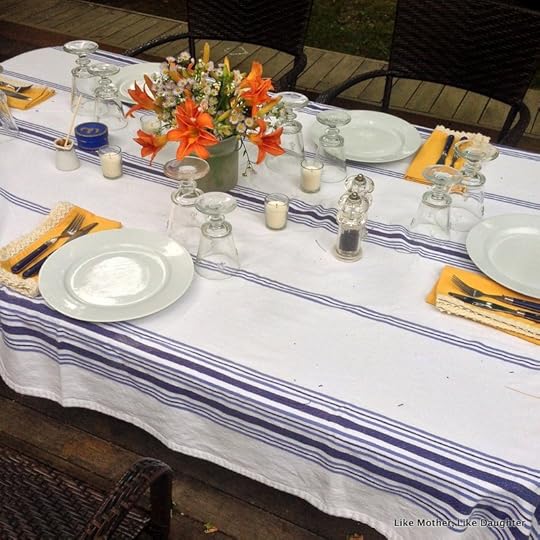
It was a simple meal of grilled salmon. I marinated it with my latest favorite marinade, very simple but very tasty: Mix a nice amount of Greek yogurt with lemon juice. Depending on how many pieces of fish or chicken you have, you can vary this, but for 5 fish steaks or 8 boneless chicken thighs I use about 1/2 cup of yogurt and 1/4 cup of lemon juice, but that is just a ballpark figure, of course. The main thing is that you want enough of the yogurt mixture to coat the pieces. Add some garlic, chopped herbs like basil or thyme, and chives. Whisk that up and coat the meat or fish.
You can do that right before you are ready to cook the other parts of the meal — set the fish or chicken to marinate and then start your rice or potatoes (we had some boiled red potatoes nicely tossed with butter and parsley, in the traditional manner, and so simple). When the grill is hot, you’re ready to cook.
Anyway, I made the simple yogurt and tahini sauce from the Ottolenghi Jerusalem cookbook: 1/2 cup yogurt (for the sauce I use regular plain yogurt, not Greek), a couple of tablespoons of lemon, ditto tahini, and a little cumin and salt to taste.
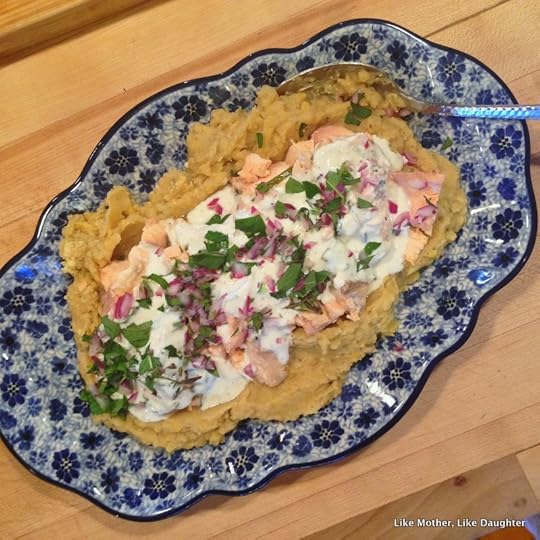
For the leftovers, I put the pieces of salmon on top of a bed of stewed red lentils. This is a really tasty and easy dish: Just cook the red lentils (much smaller and more delicate than the regular brown ones) in twice as much water. Add dried minced onion, salt, a dash of olive oil, and a little lemon or vinegar. I confess I’m not a huge fan of lentils, but this is much better than the usual fare. I had it in the fridge and it went perfectly with the salmon.
I covered everything with the yogurt sauce and garnished with some red onion and mint. We had this on pasta, but it would be very nice on rice too. Those salmon steaks (five one-inch-thick ones, on sale for the Fourth) fed five of us the first night and three the next!
Isn’t the dish beautiful? Bridget brought it back from Poland for me. I love it.
I’ve been thinking about how different things are around here now that we don’t have “slave labor” aka kids. We do our best but between being obsessed about the garden and the bees, some jobs get forgotten or continually move down the list.
But yesterday I had a visit from two lads who vastly preferred working here to being dragged around taken on visits with their mom. What hard workers! In the scorching heat they carried on. I made them sit for lunch and required the intake of ice cream cones, but otherwise, “what’s next?” was the order of the day. “We can come tomorrow and finish moving these piles.” Well, maybe… dunno about that, but great attitude!
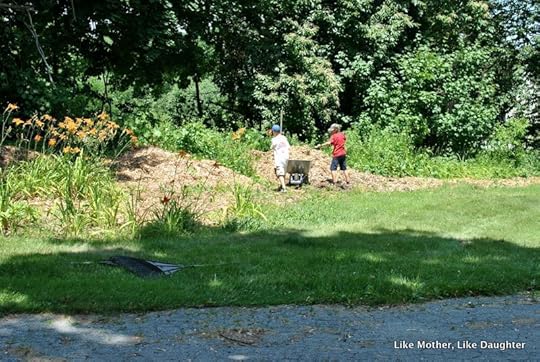
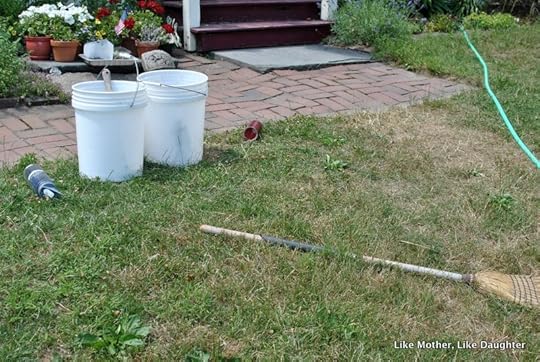
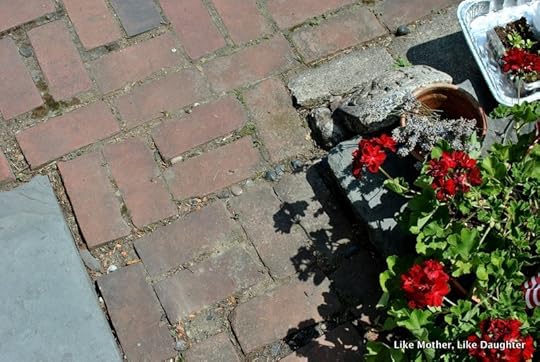
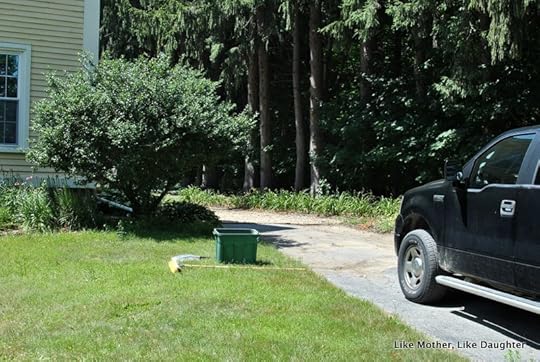
They were not without monetary compensation, but such is their upbringing in a household of 6 boys and lots of animals and chores to be done that they just wanted to work! Weeds, gone! Chips, spread! Anything else we can do? That’s the spirit!
I would only fret about those weeds, not do anything to pull them out. Thank goodness for hard-working boys!
I leave you with pictures of the garden… so happy that a friend came over and ended up helping me with the stakes the Chief made me for my 35 tomato plants — yeah, that’s a lot — tying them up while I watered…
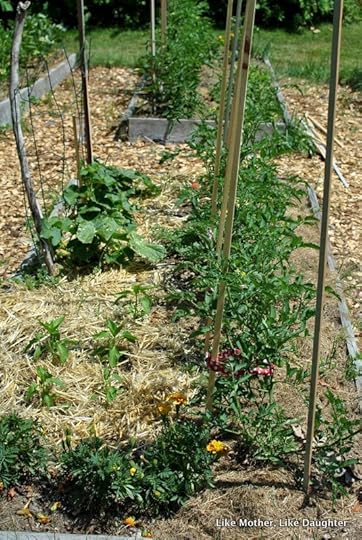
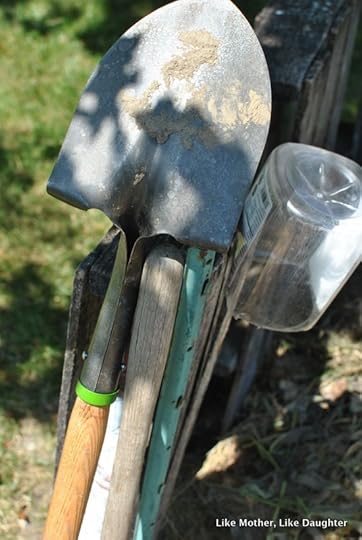
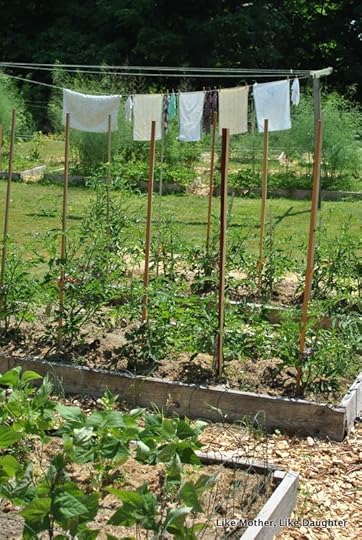





And this: Pretty, and happy, and funny, and real: My wonky brick walk –but weed-free!

[image error] Loading InLinkz ...
The post {pretty, happy, funny, real} appeared first on Like Mother Like Daughter.
July 2, 2016
{bits & pieces}
The weekly “little of this, little of that” feature here at Like Mother, Like Daughter!

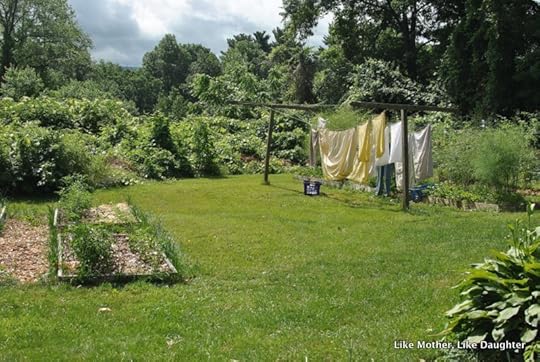





I was hanging laundry and heard a loud noise behind me. Realized it was the bees in the asparagus! They can’t get enough of those little flowers.
All would be fabulous in the garden if it weren’t for the rabbits. You’d think with a dog and a mostly feral cat (he kills an average of four squirrels a week!), we’d be good. But no.
I need a fence. Or rather, fences. The squashes are getting ravaged, the lettuce is a mere shadow of its former self. If they touch my beans…
On to our links!
This post about this little girl with many special needs (including Chiari Malformation, which Bridget also had, without Clare’s other issues) has two features to recommend it: 1. Clare’s cheerful smile, and 2. good tips on how to help a family of a child who needs extended medical care. Even with my limited experience, I can attest to how exhausting it is to be at the hospital that is almost certainly not close to home — how hungry you get, how anxious, how sleep-deprived.
A super-fun activity for kids: build your own epic marble-run! Is it raining where you are? Is it winter for our down-under readers? Kids just need a project? DO THIS.
While you are sitting by the pool, sipping your iced beverage, you can be thinking educational thoughts — that is, thoughts about education. Just as we need Sunday to gain perspective over the works of the weekdays, raising our eyes beyond the horizon long enough to see who we are and why we are working so hard, so we need a break from school to think about what our goals are. This short essay by Joseph Pearce can give us some criteria about the kind of education we want for our children. Obviously, we want to read “Great Books” — but a “Great Books Curriculum” might not be the best kind of education there is.
“The Great Conversation adds the gravity of Tradition to the study of the Great Books, allowing the ancients into the conversation with their modern counterparts, thereby enfranchising all generations, born and unborn, into the convivial communion of the Great Conversation that continually animates the life of civilized man.”
This article by Anne Maloney is a must read. We refuse to teach our children self control, we refuse to protect them, and then we wonder why they are so wounded. (Perhaps we are wounded too, living as we are with a “legacy” of libertine living.)
An interesting study on the effect of telling a woman that her baby is “too big.”
“In summary, we found that while only 20% of women with SLBs [Suspected Large Babies] go on to have a baby weighing 4,000 grams or more, the suspicion of a large baby is independently associated with greater use of perinatal interventions that are currently not indicated for fetal macrosomia and may themselves confer unnecessary risks to women and their neonates. Maternity providers may not be aware of the impact of communicating fetal size concerns to patients on their perceptions about the likely course of labor and delivery and the need for certain perinatal interventions. Future studies are needed to review current policies and practices surrounding clinical management of pregnancies with suspected large babies, which will hopefully lead to the development of guidelines that ensure that women with SLBs experience care that reflects the best current evidence and standards.” [emphasis mine] [editor’s comment: how about doing our best to encourage a woman to trust that her body was made for this job and it’s very unlikely — statistically speaking — that she will need drastic intervention to birth her child.]
From the archives:
For Independence Day, make this day about more than flag-themed desserts — we need to teach our children what we are celebrating! Practical civics through partying!
Related to the Anne Maloney piece, above: What C. S. Lewis made me think about.
And this: Standards and solidarity: Ten ways to give your child the gift of purity.
~We’d like to be clear that, when we direct you to a site via one of our links, we’re not necessarily endorsing the whole site, but rather just referring you to the individual post in question (unless we state otherwise).~
Follow us on Twitter.
Like us on Facebook.
Auntie Leila’s Pinterest.
Rosie’s Pinterest.
Sukie’s Pinterest.
Deirdre’s Pinterest.
Habou’s Pinterest.
Bridget’s Pinterest.
Habou’s Blog: Corner Art Studio.
Auntie Leila’s Ravelry.
Auntie Leila’s Instagram.
Rosie’s Instagram.
Sukie’s Instagram.
Bridget’s Instagram.
The post {bits & pieces} appeared first on Like Mother Like Daughter.
June 30, 2016
{pretty, happy, funny, real}
What is this {pretty, happy, funny, real} you speak of?
~ {pretty, happy, funny, real} ~
Capturing the context of contentment in everyday life ~
Every Thursday, here at Like Mother, Like Daughter!
Only two weeks until the movers come! I’m firmly in denial, which is an easier place to be when someone else is doing the packing for you. Soon I’m going to start thinking seriously about planning and packing up the car for our month on the road. (I have lots of ideas for the kids and the internet gave me more, but if you have any great tips, you should tell me! Pippo and Molly are pretty good travelers, but Nora is at a sort of awkward age — too old to just nap through it all and too young to be easily entertained)
While we avoid thinking about moving, we spend our days alternating between playing in the water outside (it’s generally too hot to do much else) and making fun messes inside. The kids have been playing up a storm, and I’ve been sewing. Because obviously, when you’re a few short weeks from moving halfway across the country, the rational thing to do is get started on some baby quilts, crib sheets, and toddler clothes. (Currently, this romper cut out and waiting to be sewn together.)
(Yes, they are sharing a chair. Personal space, smersonal space.)
We’re in a serious origami zone right now.
Pippo found instructions in a magazine for making a paper cup, and he folded several dozen for himself and Molly to use for rinsing out their mouths after brushing their teeth. I ordered him this book, which comes with 24 sheets of origami paper and instructions for a bunch of easy projects. For $2 and not having to leave the house to find it, I’d say that’s pretty good. We tried getting a few books out of the library, too, but the directions weren’t nearly clear enough for him to follow, even though the projects weren’t too hard.
Of course, we quickly worked through that paper and I ended up going all in with a pack of 500 sheets. Pippo was so excited that he declared the day they arrived a holiday. He’s been diligently folding sheet after sheet, with no signs of tiring yet. (I went through a big origami phase when I was younger, so I totally get it. I still love joining in!) Molly has started making her own “omagamee things” too, and they keep them all in a box (now a box and a bag or two) under Pippo’s bed.
I’m thinking we probably won’t get through all 500 before the movers get here, but with this work ethic you never know.
[image error] Loading InLinkz ...
The post {pretty, happy, funny, real} appeared first on Like Mother Like Daughter.
June 28, 2016
Taking Care of Your Core, Before and After Baby – And my Mutu Review
A while ago I mentioned that I was doing Mutu and promised that I would give you a review when I was done. The review is below. Whether or not you do Mutu, however, I’ve learned the importance of taking care of one’s midsection. I was motivated to get back in shape specifically because I hope to have more kids and I want to be strong and healthy while growing a family — in particular, I want to keep my core strong and healthy, since it’s the core that undergoes so much during childbearing! It’s worth knowing that there are things you can do before, during, and after having babies to get this strength.
We’re not exactly fitness girls over here at LMLD. We like to eat good food and go on walks (and some of us enjoy running more or less occasionally). But we’re not the type to jump on a workout program in normal circumstances. We’re not sprinting up mountains or heading for the Crossfit joint anytime soon.
But, even so, we recognize that it’s important to take care of yourself physically. And that it fits into our vocation as wives and mothers to do the best we can to keep strong and fit. This Mutu program appealed to me so much specifically because it’s designed for mothers (Mutu = “Mummy Tummy”). Not only is it about addressing issue that might have arisen from childbearing, but it’s organized to fit into the life of a mother realistically.
Some context:
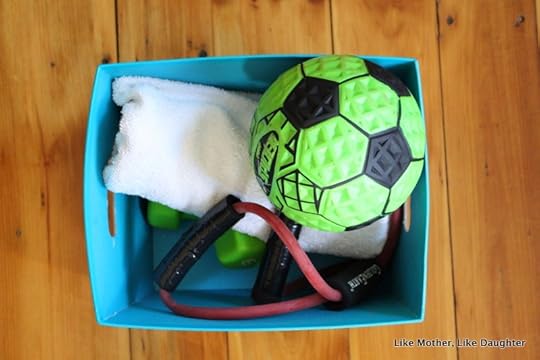
Let’s just say I’m not the tallest gal on the block, nor the one with the sturdiest build. And my babies haven’t been the smallest. Add to that the fact that, before childbearing, I never put much effort into maintaining core strength, and the result was a sad state of affairs in my midsection after Peabodee’s birth.
During my first pregnancy, I thought, “ooh, weird, my abs are separating.” I mentioned it a couple times, including to my midwife, but no one stopped me and informed me that that was not the norm nor the desired effect of pregnancy. What did I know? Everything about pregnancy was new to me, and I had never heard the topic of abdominal separation discussed.
But it definitely weirded me out, and I was concerned to have my stomach back in one piece after Finnabee was born. I asked for help and was given a few exercises to do at home. At my later check-ups, I specifically requested that the midwives check my midsection to see if things had bound back up again properly. They assured me that I was all better. Although I wasn’t convinced, I didn’t know what else to do but trust their assurance and move on.
Fast forward to my second pregnancy, which was under the care of a different midwife. Very early in the pregnancy the condition re-presented itself and I realized that my midsection was ill-prepared to carry another little one… who turned out to be not so little. Hello there, 9+ months of poor posture and 9+lb munchkin! Another blow. (I mean, a blow to my tummy. Obviously the munchkin himself is a blessing beyond belief!)
I finally got some clarity from this midwife and she did encourage me, after postpartum healing, to make some actual progress on regaining ground in the abdomen-strength area. The fact that there was something physically wrong really struck me when I happened to check my weight and discovered that I was below my pre-baby number, and yet looked heavier!
After several more months of casual searching, I realized that there’s a name for what I was experiencing: Diastasis Recti. It seems like a little thing, and might come off as simply a cosmetic concern, but actually it can inhibit overall health when it’s disrupting one’s whole plan to get fit, and threatens to get worse with each pregnancy if not addressed. No one told me that, for instance, standing certain ways was aggravating my condition. And when I did feel up for exercise, no one was there to tell me that there were certain exercises that I should be avoiding because they were counterproductive to my healing! Finally… I discovered Mutu.
My review of the program is below. But first, I want to talk about the habits of movement we have as women and mothers in our modern world, and how adjusting them can make a big difference in the care we’re taking of our core.
You can prepare your body for strong childbearing and/or recover after childbearing by making small adjustments in alignment.
Do you slouch throughout your day? I do! I find myself in positions that would make our old Irish Step Dance teacher turn over in her grave if she saw them.
The way that we tend to move, sit, and poise ourselves in our culture is counter-productive to our health in many ways, and especially unhelpful when it comes to building up our bodies in favor of healthy childbearing. We feel a lot of pressure to work out in order to look good and be strong. But if we spend, say, even 15% of our time in active exercising, we’re making our lives difficult by having the remaining 85% of our time be wasted or actually working against us.
If you haven’t had any babies yet, you can do a lot now to prepare to carry them well. (I was running three times a week and doing lots of walking the year that I got married, but I never did a thing to target my core! I had a tiny waist, but no idea that it was weak!)
Now that I’ve been introduced to Mutu, I realize that my habits were to slouch my way around through my day. Before kids, there were many months there that I just didn’t move enough, period (hello, desk job!). And then when I did start to move more, I wasn’t carrying myself well. Bending over instead of squatting, leaning around instead of standing up straight, flopping over instead of sitting.
When I was pregnant with Finnabee, I heard the advice that pregnant women should squat. Well, actually, we should all be squatting all the time! If you think about it, you need strong legs to support your midsection, especially when your midsection is going to be periodically increasing by up tens of pounds of extra person!
The first few weeks of Mutu (and all of it, really), are very big on building up squatting skills. I noticed a difference in walking up my stairs by week 3 — “wow, my legs are carrying me up instead of me sort of thrusting myself up in some vague way.”
So now I look for opportunities to squat. Ideally, back stays straight and your heels and thighs do the work. Core is engaged. (And yes, this is one reason why Western women have a harder time, in many ways, than women in traditional cultures when it comes to having babies — we hardly ever squat!)

Here are some more examples:
Slouching at the sink (and I do a lot of dishes!). Leaning my belly into the counter, shoulders usually high and tense, all the pressure going right into my mid-section, no support from my legs. Bad.
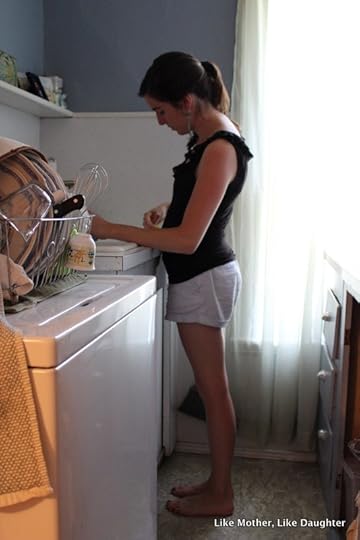
Instead: Setting my feet under my hips, rolling my shoulders back, engaging my core, lifting my chin, untucking my tail bone. Better!
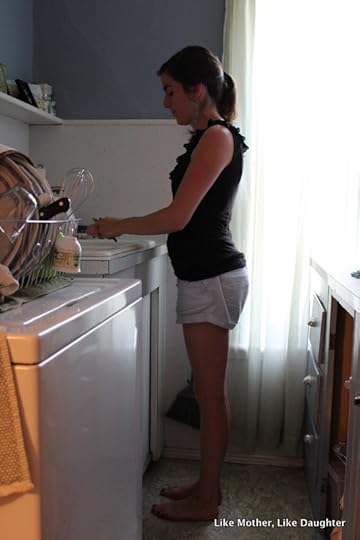
Slouching on the couch. Flopping down and leaning back with my weight gathering into my pelvis and hips, back curved around. Shoulders rolling forward. Not doing myself any favors.
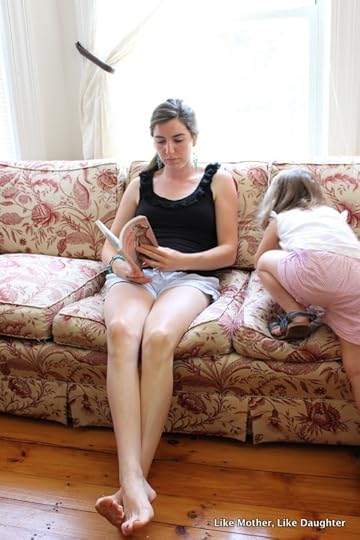
Instead: sitting so that my weight is on my “sit bones” (as they’re referred to in Mutu). In this case, sitting cross-legged so that I can relax my legs while also sitting down on my bum instead of back into a rolled-up position with my ribs collapsing towards my pelvis. Back straight, shoulders down. Not only am I improving blood flow to my head, but I’m taking pressure off of my mid-section by using my skeleton properly. Better!

Slouching in a chair (and especially at the computer!). Again, my skeleton is just flopping back, ribs caving in, and I’m not sitting upon my bum the way I should be. You can see how this is putting undo pressure on my tummy… and nor is it flattering!
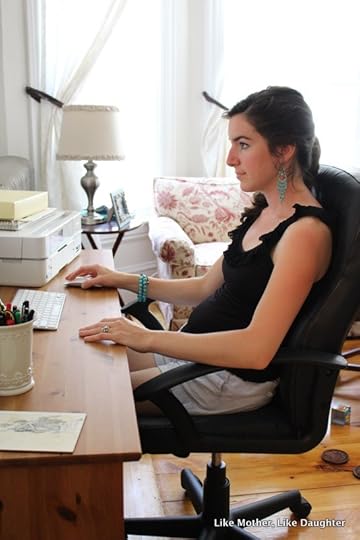
Instead: Sitting on the edge of my chair so that my feet are down on the floor, bracing me and providing support. Back straightened up, bum bones engaged, shoulders rolled down. (I can see that I still need to work on the alignment of my chin…) Better!

This is one I catch myself at all the time: when I need to reach something that’s slightly low but not really low. If I reach all the way down to the floor, I might remember to squat down instead of bending/flopping over. But when it’s not a far reach, just a little reach… I simply slouch, belly first! It’s so bad! I find myself doing then when buckling baby into high chair.
Instead: squat a little. Yes, it looks goofy (un-tuck the tailbone = rear does stick out a bit)! But it’s not as though I looked good when I was slouching, is it?
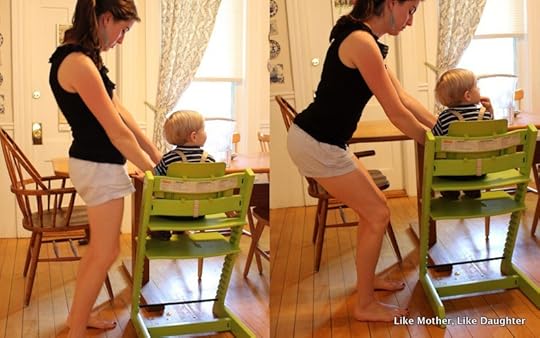
Another big one: (although I don’t have pictures): carrying the baby. It’s so easy to plop the baby on the hip, letting both hips thrust forward and one to the side, the back curving and belly going out with them. Better: square the hips over the feet, straighten up the back and roll the shoulders down, and hold the baby with the strength of the arm. This is also where proper baby-wearing comes in so handy to prevent bad posture!
I learned about all of this mainly from the Mutu System. I also found the blog Diastasis Rectified extremely helpful and have picked up a thing or two from Nutritional Movement (thanks, Rebekah, for the recommendation!). Spend a day thinking about how you move around your normal, everyday spaces and how you carry yourself. If you’re like me, you’ll find many areas where you can make small changes that will add up to a big difference in your ability to keep a strong core. I’m not going to advocate getting rid of all of the chairs in your home. But lesser changes have made a big difference to me, and now I see how much sense it makes for those of us who want to be up for childrearing in the long-term.
My Review of the Mutu System 12 Week Program
So, about Mutu. Down to the details.
Right off the bat, I will say that I’m a believer. I went into Mutu with the primary goal of closing my Diastasis Recti gap, which was about 2.5 finger widths wide when I began. I went through 9 weeks very faithfully, and then dropped off the bandwagon due to some things beyond my control. I have now dipped back in, starting at week 4.
My results? My DR gap is closed. I think I can still use some strengthening to work towards it staying closed the next time around, but I am very pleased with where it’s at and certain that I was not going to get there without a focused routine and guidance. I also have ab muscles that I’ve never had before (not that one can tell to look at me) and better overall strength. (After all these squats of every description, I’m basically like Jason Varitek over here.)
What is the System, exactly?
The Mutu System is an exercise program and, for lack of a less absurd term, “lifestyle plan” geared towards helping women close DR, regain core strength, lose baby weight, flatten tummies, and address pelvic floor issues (like “leaky undercarriage”).
You buy a subscription to the “system” and you have access to 12 weeks worth of videos and accompanying materials (as well as the Mutu Mamas Facebook group in case you want to chat with other women in the program/who have DR/who have other post-partum-physical issues). It’s designed to be done in 12 weeks, but the subscription never expires and you’ll always have access to it. Ideally, after following it for the 12 weeks, you’re strong and healed (or well on your way to healing) and can just keep it up as it suits you and your schedule, indefinitely.
The program is designed by Wendy Powell, who walks you through everything like a pal, with a manner that I must say is an impressive mix of encouraging and challenging (but mostly encouraging – there’s a very strong “you can do it, mama!” vibe throughout all the materials). She’s British and has a lovely accent and clear, calm, authoritative way of talking and presenting the material. She’s pleasant and likeable and looks inspiringly great without coming off as aggressive or immodest.
There are “core” exercises and “intensive” exercises. The core exercises are to be done every day; the intensives are sprinkled throughout the week on your schedule. There are demo videos and written guides for each one, and then videos that are paced so that you can work out “to” them. You have your own account with a module that helps you record where you are in the 12 week plan.
It’s called a “system” because there are other elements besides just the workout videos. Let me walk through them:
Core exercises. These are what I think of as “low-commitment” exercises. Yes, you need to do them twice on a daily basis. But they don’t take long, you don’t have to do them all at once, and — crucially for me — you don’t have to change clothes before hand or shower afterwards. I like to do them all at once, which means pulling up the video and running through it, then re-playing it and doing it again — takes 15 minutes. I do this during Peabodee’s naptime and Finnabee likes to do it with me. Not a big deal, once it’s in the routine, and boy does it make a difference in core strength!
Intensive exercises. These are a bit more of a commitment. Each one takes about 20 minutes and they will work up a sweat. I still do them in my living room – there’s no running or jumping – but I do change clothes to do them, so there’s that added effort.
Alignment. This has to do with the things I discussed above: learning better ways to sit, walk, move, etc. Really committing to this means ceasing to wear heeled shoes and embracing shoes that permit the natural rolling of the foot from heel to toe with every stride (or going barefoot). (Yes I did this, although I will wear heels on occasion for short periods of time, now that I’m stronger. And I’m more conscious about how they’re working against me. I’m a barefoot girl in general, so this wasn’t a big deal for me.)
In addition, Wendy encourages that you go on a ~20 min walk every day. It’s a way to build movement into your routine and actively practice proper alignment so that it becomes built into your muscle memory. She also talks about proper stride for running, further on in the program.
Eating. There is a “Mutu Food guide” that basically outlines healthy habits. For the most part, it’s about cutting out badly processed food and getting into whole foods. Drinking lots of water, getting healthy fats, and finding ways to incorporate healthy grains, etc. are other elements. This wasn’t a huge deal to me, because most of this was already part of my life. What was a big shift was the choice to cut refined sugar out of my daily diet — something that would have been unthinkable to me a few years ago but which, I have to say, did feel really great.
Breathing. This is tied into the exercise parts, above. As in pilates, there are important instructions as to how to coordinate inhaling and exhaling with each exercise move so that your muscles are properly engaged and challenged, and so that you’re not aggravating any bad muscle patterns. The big thing for me here is learning how to engage your TVA (transverse abdominal muscles): in case you were ever tempted to look thinner by “sucking in,” you can quit that habit right now! (I learned that engaging the core muscles happens on the exhale.) Wendy shows you how to engage the core properly so that you can be protecting that area, practicing all the time, and constantly working to strengthen those muscles, no matter what you’re doing.
There is also some material for learning deep-breathing relaxation, and understanding how this ties into your overall health and weight-loss efforts. But it’s just a small aspect.
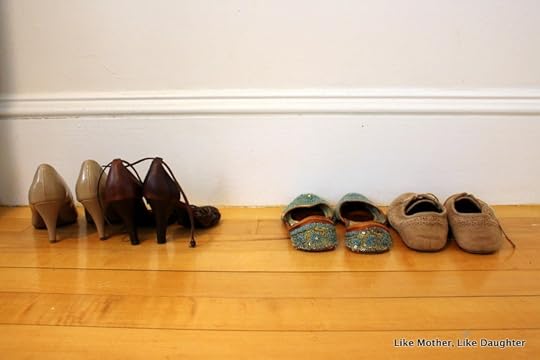
Is it realistic for a busy mom?
Well, it is a) designed to be done entirely at home and b) largely just a matter of incorporating changes into your existing routine (e.g., getting out for a walk, eating differently, perhaps).
I find that it is realistic for me, for the current season of my family life — but it is a commitment. Before I even started the program I took at least a few days to poke around the site a little, watch a couple of videos, and make a mental plan. I had to build it into my schedule. And I had to really want the results.
(Rosie says that it was a bit much with her three when she gave it a first go-round, but she’s approaching it differently a second time around and is doing better.)
I like the fact that the core exercises, which are such a big part of it, are not disruptive to the flow of the day (again, not only are you not going to the gym, but as long as you’re dressed comfortably, you don’t even have to change clothes). But even these require a certain level of determination on your part. We all know that it can be hard to set aside 15 minutes for anything on a regular basis! But once you do so, and you build it into your routine, it’s not that big of a deal.
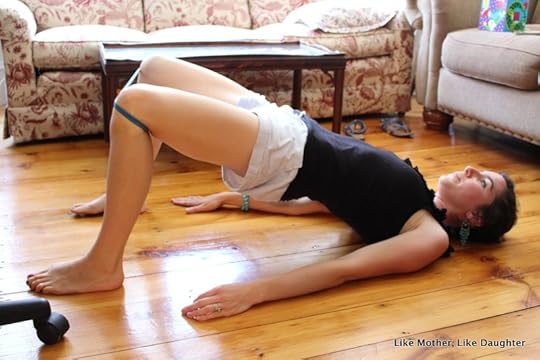
A doable approach
Wendy eases you in. Week 1 struck me as peaceful and gentle – not overwhelming in the least. Week 2? I can totally do this. I’m pretty sure anyone can do this. Week 3? A bit surprised by the first Intensive workout and a bit sore after! By week 4 I was engaged and already feeling so much stronger and more alive – and by then I was already a third of the way done!
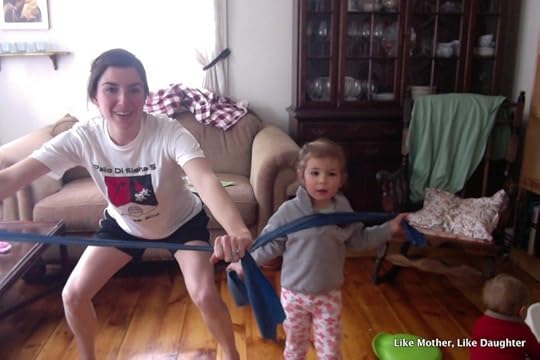
Bottom line: Is it worth it?
If you are already physically fit, or don’t have any issues specifically relating to post-partum physical health (like ab separation or pelvic floor weakness), then you might be better off just figuring out whatever core strength exercises would be good for you and going with them. (And I do recommend that you do get/keep a strong core, so that you won’t run into these problems when/if you do have a baby!) If you are looking at post-partum issues, as I was, and really just need a tool to walk you through the steps to building that strength back up and healing those specific problems, I do give Mutu a strong recommendation.
I had enough questions and concerns that I really needed someone to just stand there and tell me what to do. I also liked the aspect that I could log onto the Facebook group if necessary to get clarification on anything, because I like to know why I’m doing a given exercise or whether I’m doing it correctly. Short of having a personal trainer and DR specialist come to my home on a daily basis, this really seems to be to be the best possible option for someone in my position. (And actually, a personal trainer would be more difficult to schedule!)
As I said, my DR is basically healed. I have a much stronger core than I have possibly in my whole life. Another benefit that I experienced while in the midst of the program was a major energy boost: Getting out for a walk, whether it’s sunny or cold, is just a great habit in any case and good for the psyche; focusing on eating healthy, energizing food and no sugar really did wonders; and the habit of daily moving, exercising, and stretching were obviously generating good blood flow, etc. It was work, but very rewarding!
It’s not going to be a magic trick for tummy-flattening. For one thing (for most of us), there are some changes to the stomach from childbearing that nothing is going to undo. Mutu did help me reclaim the shape of my core, but day to day and throughout the month, I still vary in whether I look a little dumpy around the mid-section. (I’m now figuring out that I may have some gut health issues to sort out, as my problem is bloating — I know that I’m not carrying extra weight.)
In full disclosure, I did receive a complimentary subscription in exchange for this review. Not only could my perception of the program be different, not having paid for it, but it also gave me extra motivation to do it well, because I wanted to make sure I was giving it the true college try so that I could tell you about it with accuracy.
Looking back, though, I can honestly say that I would definitely feel that it was worth the money to me, if I’d have paid for it (or at least bought the abridged version, the Focus Program – and I was looking at sale prices). Someone else could get the same results on her own, but I know that I needed help.
It’s also worth noting that, unless you happen to have all the equipment handy already, you’ll pay for more than just the program itself. You will also need a small ball and a few different types of pilates bands/loops, as well as small weights. There are a few other big objects that you can improvise, but a big exercise ball would be useful as well.
Speaking of sales — I wanted to write this post now so that, if you’re interested, you could take advantage of an upcoming sale: the programs will be 45% off on July 6!
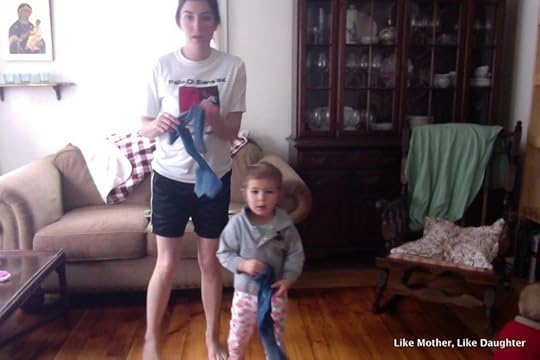
Any tips for success?
If you’re gonna do it, plan for it. Don’t try to start it tomorrow without having thought through how it’ll fit into your days and weeks.
I did a lot of my Intensives at night after the kids went to bed. Otherwise, I did them during nap times or on the weekend when the kids were occupied with Dad.
Do the homework on the Intensives before jumping in. Once I realized that there were actually only 5 exercises and I was just doing them over and over, they became much more doable. But they caught me off guard at first.
The core exercises are fine to do with your bigger kids in tow, but I found (and I know that Rosie did too) that they’re just not going to work with the baby/little toddler in the room. Too much temptation to sit on Mommy’s head/lie across Mommy’s back/play the drum on Mommy’s tummy.
It really helps if you can enlist your wonderful husband to see you through some of the workouts you don’t want to do. There were several nights when I said, “I could do my Intensive… or I could just sit here,” and the Artist stood up and said, “I’ll do it with you.” Clutch.
Here’s to having babies, healthily!
I hope I’m remembering everything… I will respond in the comments if you have any questions! This time around, the links above are affiliate links, which means I’ll get a bit if you end up purchasing a Mutu program after clicking through – so thank you!
What other tips do you have for staying strong in order to/while rais(ing) a family?
{You might also be interested in: Ask Auntie Leila: Five Steps to Feeling Pretty After the Baby)
Save
Save
Save
Save
Save
Save
Save
Save
Save
Save
Save
Save
Save
Save
The post Taking Care of Your Core, Before and After Baby – And my Mutu Review appeared first on Like Mother Like Daughter.
June 25, 2016
{bits & pieces}
The weekly “little of this, little of that” feature here at Like Mother, Like Daughter!
The winner of the beautiful Infinifeed scarf from Designs by Pebblehut is Theresa B!
Letty is generously offering free shipping on all orders over $30 until the end of July! So head on over there to make your fashion/nursing scarf/headband purchases!
I hope your garden is going well! Ours is, though it’s very dry. But wow, sunny beautiful days!

Our links this week:
First — big news: thanks to Deirdre, we have updated and upgraded our information page about the St. Gregory Pockets — what they are and where to find them. Now you can know all you need to know and also share this one page with others. Please read and tell us what you think — and share with your friends! Is your area/town on our list? Could you start a Pocket where you are?
Dr. Ralph Stanley: “It used to be said that when you heard a Ralph Stanley tune, you either wanted to get drunk or go to church and get saved.”
Rest in Peace.
Pope Francis has said some confusing things about marriage this week. It’s important that we know what we’re talking about. Yes, marriage is in a sorry state, as unto a crisis. No question about that. We need clear teaching now more than ever!
Benedict Nguyen, canon law professor, writes on principles we must keep in mind. If anything, in this excellent piece he understates the devastating effect of confusion on children.
Ed Peters, a highly respected canon lawyer, writes in First Things with some trenchant remarks about the nature of marriage — it’s not a lofty, unreachable ideal; it’s actually the very institution that virtually everyone participates in and needs. If anything, in this excellent piece he understates the essentially public — not private — nature of marriage. Think of it this way: Society is built marriage by marriage.
Marriage preparation begins in the family. There is no substitute for family life in teaching the virtues necessary for… family life! Good marriage preparation before the wedding can be found here: Catholic Marriage Prep. (We’ve told you about them before.)
And from a young priest: “Fight for your love, instead of doubting it!” Is Your Marriage Valid?
In other links:
Does your family build thing-a-ma-jigs, like Cristina’s family does? Wish we had!
This week’s little modern philosophy lesson, as we are indeed living in a Hobbesian world, alas.
“Today, I lost my Nobel prize.” A bit about a new film on the life of Jerome LeJeune, Catholic doctor who discovered the genetic reason for Down Syndrome and fought against what he knew would be the result of his discovery: the elimination of “the unfit.”
Sir Robert Baden-Powell, founder of the Boy Scouts, hid maps in bug drawings.
From the archives:
If it’s hotting up where you are, you can assemble the ingredients for our family favorite, Salade Nicoise, as you make other suppers, and then when it’s really unbearable, voila! dinner is made. This post has, in that random way of mine, my recipe for olive oil-raisin-honey-rosemary bread, so choose a cool morning to make a few loaves of that as well!
Today is the feast of St. William of Monte Virgine, Abbot.
~We’d like to be clear that, when we direct you to a site via one of our links, we’re not necessarily endorsing the whole site, but rather just referring you to the individual post in question (unless we state otherwise).~
Follow us on Twitter.
Like us on Facebook.
Auntie Leila’s Pinterest.
Rosie’s Pinterest.
Sukie’s Pinterest.
Deirdre’s Pinterest.
Habou’s Pinterest.
Bridget’s Pinterest.
Habou’s Blog: Corner Art Studio.
Auntie Leila’s Ravelry.
Auntie Leila’s Instagram.
Rosie’s Instagram.
Sukie’s Instagram.
Bridget’s Instagram.
Save
The post {bits & pieces} appeared first on Like Mother Like Daughter.









